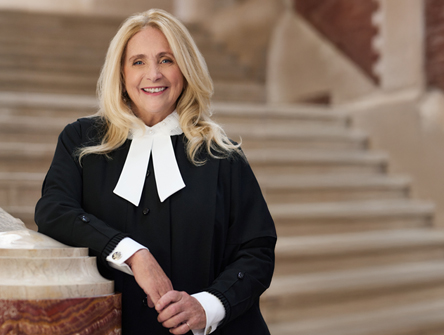The evil of climate change
What the Federal Court's ruling in Syncrude v. Canada says about our fight against climate change.

With the Prime Minister in New York City, meeting with the Secretary General of the United Nations to discuss what Canada is doing to address climate change, there’s a legal question that could frustrate any regulatory effort: is pollution an ‘evil’ that Parliament has the right to criminalize?
Harper can rest easy knowing that, according to the Federal Court, it is.
In a decision handed down in August, Justice Russel Zinn of the Federal Court found that Ottawa’s efforts to promote clean energy were perfectly in line with its powers. In doing so, he put a nail in the coffin of industry’s efforts to overturn legislative programs to combat climate change.
The case, Syncrude v. Canada, upheld rules under the federal Renewable Fuels Regulations (RFR) requiring diesel producers to mix in at least two per cent renewable fuels into their product. The oil giant had argued that the regulations, nominally made under the Canadian Environmental Protection Act, (CEPA) were both beyond Ottawa’s constitutional authority, as well as its regulation-making authority. It also argued that the Environment Minister denied procedural fairness to Syncrude by unduly rejected its complaint.
In summarizing Zinn’s decision, University of Calgary professor Martin Olszynski writes — “Federal Court to Syncrude: climate change is a real, measured evil, whose harm has been well documented.”
There was nothing to suggest that Syncrude’s case relied relied on climate skepticism per se, but it did question Ottawa’s ability to combat the phenomenon.
The company contended that the RFR regime had not appropriately considered the entirety of the issue that the rules were supposed to address — and that the government couldn’t prove that requiring more biofuels was in fact useful combatting climate change. In fact, the suggestion was that it could make it worse.
Zinn notes, “Syncrude further argued that because the RFR did not actually produce the alleged intended effect of reducing GHG emissions, the dominant purpose must have been to create a demand for renewable fuels and benefit farmers.”
Much of their case danced around that idea — that the pith and substance of the legislation falls outside of Ottawa’s realm, because it is not truly an environmental or health concern. Syncrude argued that the federal government financial commitment to promoting renewable fuels industry was proof that the purpose of the regulation was to create a market and boost biofuel production.
For that reason, the criminal prohibitions associated with failing to meet these requirements — up to $12 million in fines — runs contrary to the goal of the legislation.
Intertwined in that argument is an assertion that Ottawa has no business interjecting itself into the matter.
“Read alone and without reference to its enabling statute, [RFR] is a prohibition on the production, importation, or sale of diesel fuel that contains less than 2% renewable fuel, and thus one could suggest, as Syncrude does, that it deals with local works and undertakings, property and civil rights, matters of a merely local or private nature, or the development of non-renewable natural resources – matters that fall within provincial, rather than federal jurisdiction,” Zinn writes.
But that’s where, the judge says, everything falls apart. The RFR scheme is directly linked to CEPA, which notes explicitly that its legislative goal is to address global warming and that “where there are threats of serious or irreversible damage, lack of full scientific certainty shall not be used as a reason for postponing cost-effective measures to prevent environmental degradation.”
To that end, Zinn concluded, “there is nothing unconstitutional about Parliament taking steps to address the threat of [greenhouse gas] in the way it thought best, based on the evidence available to it at the time.”
And, as the Minister of the Environment pointed out for the court, as summarized by Zinn, “the pith and substance analysis is not concerned with the efficacy of the law or whether it actually achieves its goals – this is a concern properly directed to and considered by Parliament.”
Even so, the court noted, Syncrude did not offer a compelling case in arguing that the rules haven’t worked.
As for the criminal component of the regulations, Zinn did accept that “on its face, the RFR appears to be more regulatory in nature than prohibitory.” Syncrude had flatly rejected the idea that fossil fuels are any sort of “evil.” And “if this were a valid exercise of the criminal law power,” Syncrude theorized, “it would give ‘limitless definition’ to criminal law.”
But in relying on R. v. Hydro Quebec, a Supreme Court case wherein the top court defended Parliament’s right to slap fines on companies responsible for toxic dumping, Zinn found that “I am of the view that this particular evil – [greenhouse gas] emissions by combustion of fossil fuels – is not well addressed by specific prohibitions. For example, much of society runs on fossil fuels and Parliament should not be expected to prohibit the use of fossil fuels entirely in order to meet progressive goals of GHG emission reduction.”
University of Calgary law professor Nigel Banks, writing on the ABLaw blog, underscores that this is the first constitutional challenge to the government’s environmental regulation that seeks to tackle greenhouse gas emissions. He notes, “the decision confirms that the courts will not interfere with the manner in which the executive goes about meeting its policy objectives even if the efficacy of the measure (either absolutely or comparatively) may be open to question.”
As Olszynski concludes, in referring to the government’s uncertainty whether the courts would uphold its criminal law powers to tackle environmental degradation, “Justice Zinn’s decision would seem to be put any doubt to rest, while at the same time swinging the criminal law door open for all manner of schemes to control GHG emissions, including cap and trade.”
Shaun Fluker, also writing on the ABlaw blog, notes that “it seems to me there was little prospect of success on these administrative law arguments by Syncrude,” adding that the company faced an “unbearably high burden of showing not just the prospect of success but more than a reasonable probability of success in their arguments, before even getting the chance to argue their case on the merits.”
Calgary-based lawyer Scott “Rusty” Miller says the decision is congruent with previous Supreme Court decisions on the matter, but the whole thing leaves one question: “Where was Syncrude going with this?”
As Miller points out, the cost of incorporating that 2 per cent biofuel is minimal, and — given that Syncrude doesn’t produce enough diesel to cover the gap that biodiesel anyway — probably unavoidable. “If cost isn't the motivation,” he says, “what were they trying to prove?”
According to Miller, the goal may have simply been to establish that biofuel, given that biofuels could actually be more resource-intensive, depending on the type of grain used, isn’t in and of itself better. To that end, Miller says of Syncrude’s logic, “are we catering more to the agricultural business than the environment?”
But, he says, Syncrude was probably flat-footed in their approach given its “ineffective” policy argument.
Nevertheless, the decision is significant.
With Prime Minister Stephen Harper and Environment Minister Leona Aglukkaq in New York this week for a series of high-level meetings set up to address climate change, the decision puts some wind in his sails if he were to vow to bring some of the proposals back home.
The Prime Minister, however, has been at best lukewarm about the RFR rules, which his government introduced in 2010, after his government promised a 17 per cent reduction in 2005 greenhouse gas levels by 2020.
That goal seems virtually impossible, especially as he appears to have ruled out any unilateral programs to address the issue.
But, if he changes his mind, the courts have his back.


